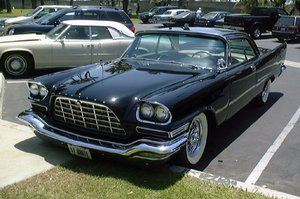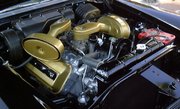Chrysler 300 letter series
|
|
- This page is about the Chrysler 300 cars from the 1950s and 1960s. There is also a modern Chrysler 300 page
The Chrysler 300 "letter series" were high-performance luxury cars built in very limited numbers by the Chrysler Corporation in the United States between 1955 and 1965. Each year's model used a new letter of the alphabet as a suffix (skipping I), reaching 300L by 1965 after which the model was dropped.
The 300 "letter series" cars were the vehicles that really rekindled interest in performance among major US manufacturers postwar and thus can be considered the muscle car's ancestors, though much more expensive and exclusive.
Chrysler has recently started using these designations again for sporting near-luxury sedans, using 300M from 1999, and continuing the 300 series with a new V8 300C, the top model of a relaunched Chrysler 300 line, a completely new rear-drive car launched in 2004. This is disliked by some fans of old Chryslers who do not approve of the re-use of a 300 letter series designation. Unlike the first series, the second does not have 300-horsepower engines.
| Contents |
1955 C-300
Chrysler_C-300.jpg
This first of the letter series cars didn't actually bear a letter; it can retroactively be considered the '300A'. The 'C-' designation (later dropped) signified 'Coupe', while the 300 originally stood for the 300 horsepower (220 kW) engine. The C-300 was really a racecar sold for the road for homologation purposes, with MOPAR's most powerful engine, the 331 cubic inch (5.4 L) FirePower "Hemi" V8, fitted with twin 4-barrel carburetors, a race-profiled cam setup, solid valve lifters, and a performance exhaust system. This was the first US production car to top 300 horsepower (220 kW), and the letter series was for many years the most powerful car produced in the United States by a fair margin. The car was designed by Virgil Exner, the Chief of Design at Chrysler, and was noted for its "Forward Look" styling. The grille was taken from the Imperial of the same year, but the rest of the car did not look like an Imperial. No exterior mirrors were fitted, for reduced drag at speed. Measured at 127.58 mph (205.32 km/h) in the Flying Mile and doing well in NASCAR, the C-300 aroused a lot of interest that was not reflected in its modest sales figure of 1,725 built.
1956 300B
Chrysler_300B.jpg
1956's car was fairly similar externally, but with larger engines, two models of 354 cubic inch (5.8 L) Hemi V8 with either 340 or 355 horsepower (254 or 265 kW). Only 1,102 were sold. Performance was a little better than the previous year's, being measured at almost 140 mph (225 km/h).
1957 300C
1957's Chrysler 300C is generally considered the classic year of the 300 "letter series". New styling was brought in, with a yawning wide front grille and fins; the Hemi engine was upgraded to 392 cubic inches (6.4 L) and 375 horsepower (280 kW), or as a very limited edition 390 horsepower (290 kW) version (18 built). A convertible model was available for the first time. The car had a number of red, white and blue '300C' medallions on sides, hood, trunk and inside. 1,767 coupes and 484 convertibles were built.
1958 300D
1958 was to be the last year of the old FirePower Hemi in the 300. This year's engine was still 392 cubic inches (6.4 L), but tuned to 380 horsepower (283 kW) as standard. 35 cars were built with electronic fuel injection and delivered 390 horsepower (290 kW), but the fuel injection equipment was troublesome and most cars soon had it replaced with the standard twin-quad carburetor setup. A 300D was driven to 156.387 mph (251.680 km/h) at the Bonneville Salt Flats that year, but only 618 hardtops and 191 convertibles were produced, partly thanks to recessionary times.
1959 300E
1959 saw the Hemi engines replaced by Chrysler's new Golden Lion wedge-head V8 at 413 cubic inches (6.8 L) displacement. Power output remained about the same. The loss of the Hemi and the late-50s recession meant for poor sales of 522 coupes and 125 convertibles.
1960 300F
Chrysler_300F.jpg
Chrysler_300F_cross_ram.jpg
1960's 300F introduced a new, higher power 413 in³ Wedge engine delivering 375 bhp in standard form. To boost power at lower and mid RPMs, a special "cross-ram" intake manifold was derived. Instead of the normal V8 central intake manifold with carburetor(s) on top, the cross-ram consisted of two pairs of 30 inch (760 mm) long tuned pipes that criss-crossed so that each set fed the opposite side of the engine. The carburetors and air cleaners hung off the sides of the engine over the fender wells. These long tubes were tuned so that resonances in the column of air helped force air into the cylinders at those engine speeds.
A special 400 bhp (300 kW) "short ram" version was produced for competition; in this, the tuned portion of the stacks was only 15 inches (380 mm) long, so that the resonant effect was produced at higher engine speeds. Only 15 "short ram" cars were produced; these were also fitted with French Pont-a-Mousson 4-speed manual transmissions developed for the Chrysler-powered Facel Vega.
The bodywork was also redone for 1960, using Chrysler's new lightweight unibody construction and given sharper-edged styling with outward-tilting fins that were visually separated from sides.
Sales increased to 969 coupes and 248 convertibles.
1961 300G
The 1961 300G saw another restyle. The grille, formerly wider at the bottom than the top, was inverted; the quad headlights, formerly side-by-side, were arranged in angled fashion, inward at the bottom, in a manner reminiscent of the 1958-60 Lincolns. Small parking lamps below the headlights were likewise slanted and V-shaped, and the front bumper was canted up at each end, scoop-like. At the rear, the taillights were moved from the fins to the tail below them, and the fins were made sharper-pointed.
Mechanically, the cross-ram "short ram" and "long ram" engines remained the same, although the expensive French manual transmission was dropped, replaced by a standard Chrysler 3-speed.
1962 300H
From 1962's 300H, the fins were gone after stylist Virgil Exner left Chrysler. Gone, too, was the letter series' unique place in the Chrysler lineup; there was now a whole Chrysler 300 series, of which the 300H was but the top model. Externally there was little difference between the 300H and the plain 300, and many of the 300H's features could be ordered as options on the other models. Under the hood of the 300H, the same long ram and short ram Chrysler RB engines were still there. With a slight power boost and a 300 lb (136 kg) lighter body, the 300H was faster than the 300G, but the loss of exclusivity coupled with high prices made this the slowest-selling letter series year yet, with only 435 coupes and 135 convertibles sold. The regular 300 (non-letter) series used a 383 B engine.
1963 300J
Further restyling for 1963's 300J (the letter "I" was skipped) left the car with a smoother, more angular 1960s look. The convertible was dropped, leaving the coupe; the "short ram" racing engine was also discontinued. The only engine available was the 413 in³ (6.8 L) "long ram", with an increase of 10 bhp (7.5 kW) from 1962. A redesigned and more sumptuous interior featured an oddly squared steering wheel. The 300J was faster than the standard 300H of the year before, with a 142 mph (229 km/h) top speed, 8.0 seconds 0-60 mph, and a standing quarter mile time of 15.8 seconds with a terminal velocity of 89 mph (143 km/h). Sales were especially poor, with only 400 cars produced.
1964 300K
The convertible returned for 1964's 300K, but the "cross-ram" engine became an extra-cost option available on the 300K only. A 413 in³ Wedge with a single 4-barrel carburetor, a regular intake manifold, and 360 horsepower (268 kW) was the new standard engine. Leather upholstery was no longer standard either. All this reduced the baseline price by over a thousand dollars, and sales responded with the largest total ever; 3,022 coupes and 625 convertibles.
1965 300L
1965's 300L was the final year of the traditional letter series. A complete restyle brought a sleek mid-sixties linear look to the cars. The cross-ram engine was no longer available; the 413 in³ (6.8 L) engine with regular carburation and inlet manifold was the only one supplied. Practically every feature on the 300L could be ordered as an option on the regular 300; the only absolute difference was the '300L' badges. 2405 coupes and 440 convertibles were sold.
300 letter series cars today
All original letter series cars are considered collectible as of 2005, but the early years are much more desirable. The C-300 and 300B, being less tractable as road cars, are slightly cheaper than the subsequent years. The 300C through 300G are the most desirable; the coming of the regular 300 series cars in 1962 makes the subsequent letter series seem less special and less desirable to collectors.


